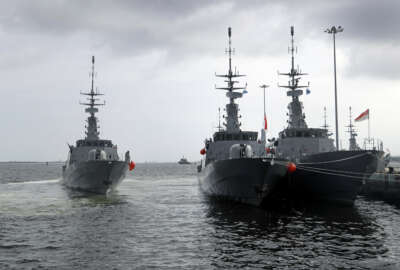The Navy wants to get next generation and new platforms on its ships as quick as it can and it’s willing to make some tradeoffs to do it.
Test and evaluation has long been the bane of some acquisition officials and even warfighters waiting to get the gear they need. On the other hand, without test and evaluation equipment is delivered before its ready or safe for troops to use.
The Navy is using some of its new acquisition authorities to try and solve that problem.
In the past with new ship weapons and platforms the Navy would send the weapons to Combat System Engineering Development site in Moorestown, N.J.
“We used to send [the weapon there] with the computers, with the program. We used to send the operators up there. They’d test it, they’d try it. Then we’d go set up a fleet exercise. We’d go shoot a missile and we’d do a report on that and then the report would come back a month later and the report would say ‘We should have done this’ and then rinse and repeat and time is wasting,” said Rear Adm. Ronald Boxall, the director of Navy surface warfare during a Jan. 9 speech the Naval Surface Association Conference in Arlington, Va.
Boxall said the Navy is moving to a modeling and simulation environment paired with live-fire testing to deliver platforms at a higher speed.
“We are trading risk here. We do not want to get less rigor, but we’ve got to give up a little bit of that timeline and we have to have good confidence that we can go forward because our models match what we have on the ship,” Boxall said.
The Navy will put more emphasis on warfighting labs, people on the ships and modeling and simulation to quicken the process. In addition, virtual testing will speed things up, Boxall said.
“The testing we do, we will do it faster, we will do it better because we have modeled the information eenvironment that we are going to be operating in more closely than we have now,” Boxall said. “As we continue to develop this and go more quickly, the spectrum of what you are changing is big. Some things are very small. They are very quick, they are very easy and some things are very complex and very complicated. At the lower level there’s much less risk at the higher level there is more risk so we have to figure out how it fits with that modeling.”
The Navy was given more leeway to on the number of programs it controls in the 2016 defense authorization act.
The law delegates more acquisition process authority to the military service chiefs instead of keeping it in the Pentagon.
That means the Defense Department has been offloading programs back to the services where they are able to work more hands on and to make more service-centric decisions.
The Navy wants to make the platforms it puts on its ships more standard. Instead of fitting just one ship with the latest radar or vertical lift technology, the service wants to make common combat systems that can fit on multiple ships at a time.
“How are we integrating across the force?” Boxall said. Right now “the challenge is every time you make an improvement in a system you have to go back and now you have to make every system kind of match up and you Band-Aid this system together. That’s no way to get to that future we have to get to, to have more speed and agility and drive that cost down.”
Boxall said a common combat system will create a wider view for platforms.
Copyright
© 2024 Federal News Network. All rights reserved. This website is not intended for users located within the European Economic Area.
